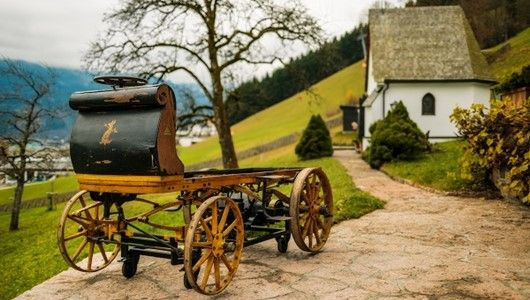Ferdinand Porsche Went Electric With His First Car; Check Out Photos Of The P1 Electric Car Unearthed After A Century

Years before Ferdinand Porsche helped Nazi Germany create some of the most terrifying tanks of World War II, the Austrian-Czech engineer was playing around with electric vehicle technology. Now one of those EVs has been discovered in a private barn and will make its public debut on Friday at the Porsche Museum in Stuttgart.
The discovery shows just how far back electric vehicle technology goes even if it hasn't really taken off in the mass market. Even today, with over a century's worth of stop-and-start EV development, the EV market share is a sliver of the total industry. Last year, only 96,702 EVs were bought in the U.S., the world’s second-largest auto market, according to the Electric Drive Transportation Association. U.S. consumers bought 15.9 million new vehicles in the same period of time.
The car, a horseless carriage dubbed the P1 but officially called the Egger-Lohner electric vehicle, C.2 Phaeton model, was certainly not the only electric vehicle at the time. But it was one of the earliest and one of the first cars produced by the namesake for the famed German brand that's now a subsidiary of Volkswagen AG (FRA:VOW). Ferdinand built the P1 himself in 1898, at the unripe age of 22, at the request of a private car builder who wanted an electric drivetrain, and a year later, the P1 took first place in a 24-mile race at a Berlin electric-vehicle expo, according to Porsche. The P1 crossed the finish line 18 minutes ahead of the second-place winner, whose name is lost to history.
More than a third of the carriage’s weight came from the 1,100 pounds of batteries needed to churn out 3 horsepower. The car could travel 49 miles on a charge, which isn’t bad considering that most modern EVs can’t travel twice that distance. Its top speed: 21 miles per hour.
Porsche says the car was discovered in a warehouse where it had remained untouched since 1902. No more details about the circumstances behind the discovery were provided. Photos of the exhibit show the vehicle with plastic sidewalls to offer viewers a picture of how the vehicle looked in its original form, suggesting it was not exactly in mint condition. Still, the powertrain is there, along with the original wheels and much of the wooden carriage.
Ferdinand went on to create a hybrid version of the vehicle, the Lohner-Porsche Mixte, and, more important at the time, the world’s first all-wheel drive passenger car. Unfortunately for EVs, battery technology could never catch up to what were essentially early proofs-of-concept.
And unfortunately for Ferdinand, a decorated member of the Third Reich’s murderous Schutzstaffel (SS), Germany’s war effort took him away from his work developing race cars and forever tainted his genius with the stigma of the Iron Cross. While the war suspended Ferdinand’s work on the Porsche 64, considered the first vehicle from what would later become the Porsche auto company, Ferdinand’s son went on in the late 1940s to create the iconic Porsche 356, the company’s first mass-produced vehicle.
© Copyright IBTimes 2024. All rights reserved.












